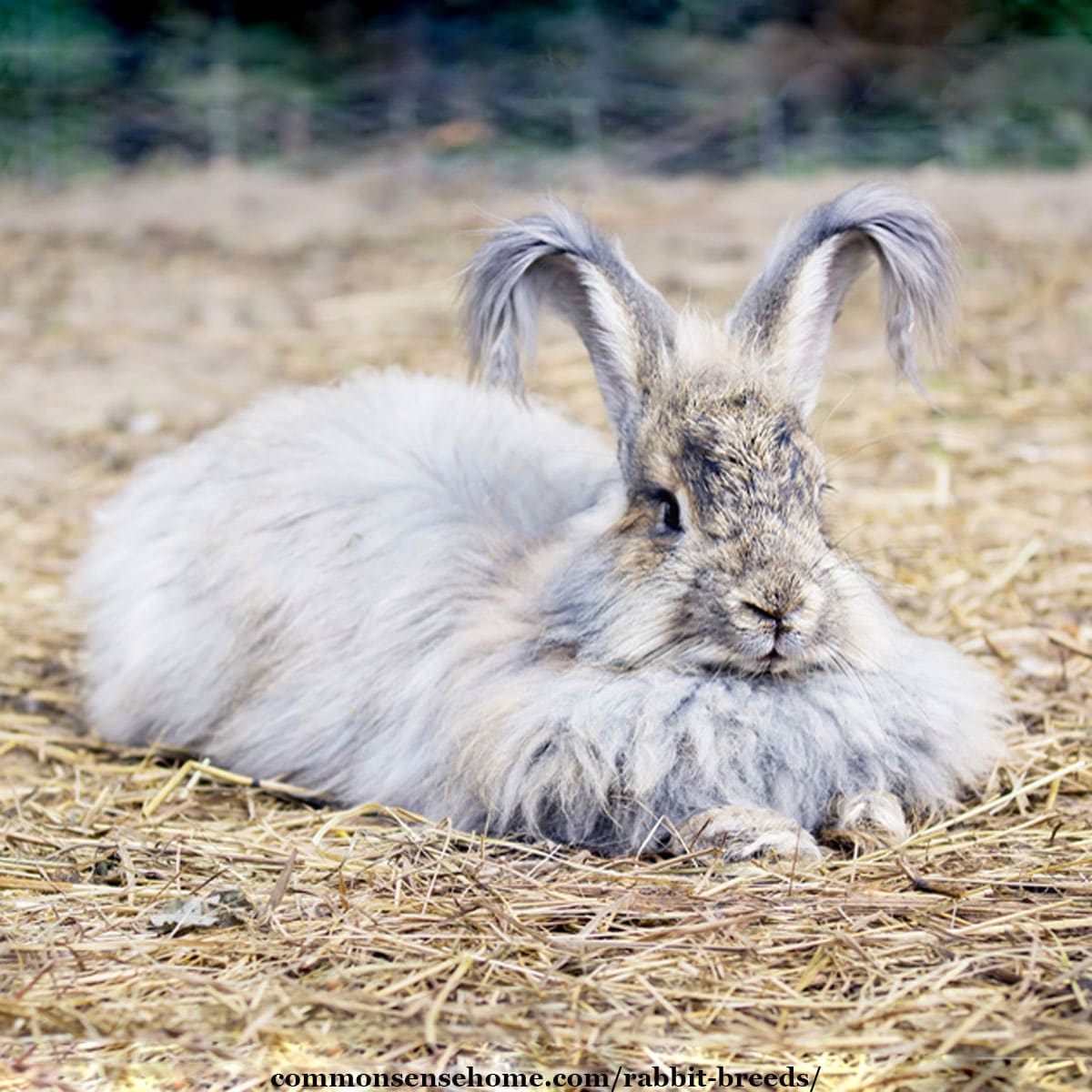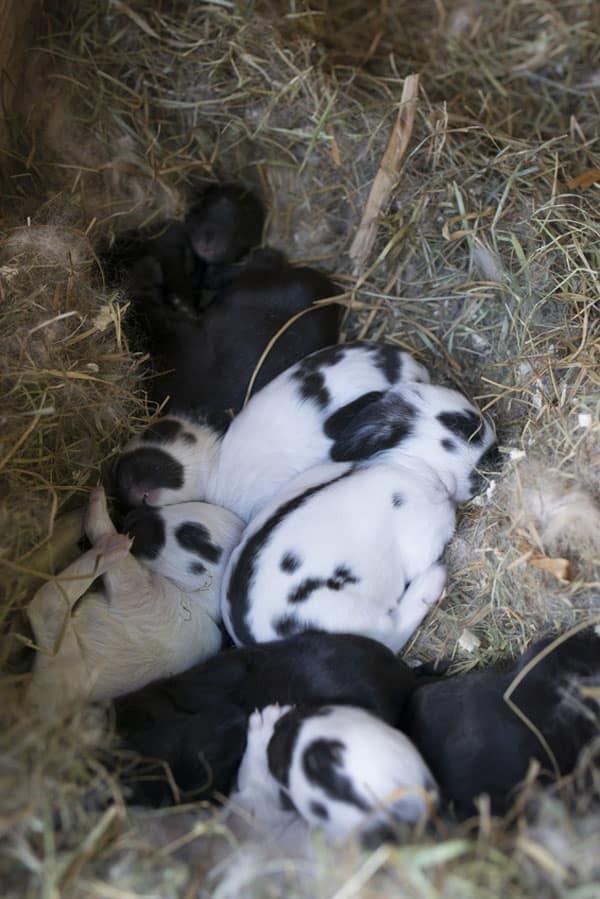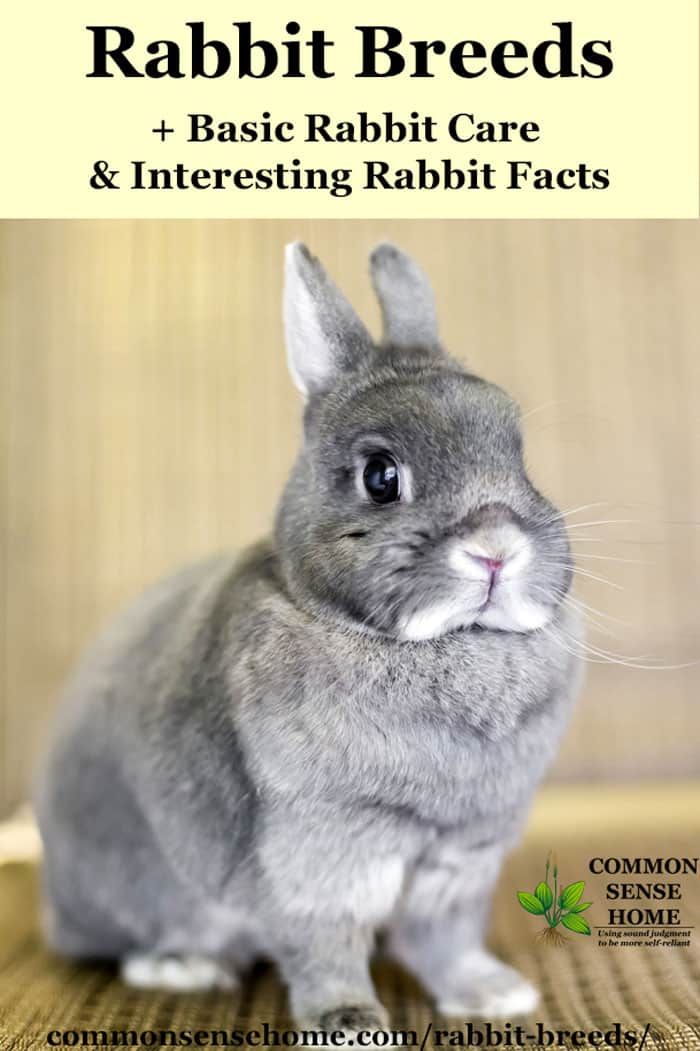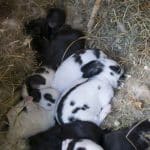Rabbit Breeds & Basic Rabbit Care
This post may contain affiliate links. Read my full disclosure here.
Rabbits are easy to care for because they take up very little space, make no noise and won’t disturb neighbors. We’ll discuss rabbit breeds, basic rabbit care, and some interesting rabbit facts.

Rabbit Breeds – Pets, Fiber, or Meat?
There are four basic rabbit colors – black, blue, chocolate, and lilac. Within these colors, there are different mixes and patterns, and fur textures.
To make it easier to choose the best rabbit breeds, I like to put them into three categories.
Pet Rabbit Breeds
The best pet rabbits breeds include:
- Lionheads
- Netherland Dwarfs
- Dutch rabbits (medium sized with characteristic black and white colored markings)
- Holland Lops
- Mini lop
- Satins
- Mini Rex
- Rex Rabbits
- Harlequin rabbits – has unique patterned colored markings
- Himalayan rabbits – one of the oldest breeds
These rabbit breeds are best-suited as pets. They are small, cute and easy to take care of. Pet rabbits are perfect for a young child to learn some responsibility or to display at a 4H show.
Their waste makes a wonderful addition to a garden or the compost pile. A breeding pair may cost around $25-30, and they require about 2 ounces of food per day.
Pet rabbits are the third most common animal to end up in shelters, behind dogs and cats. Please be certain that you really want a pet bunny before you make the commitment. House rabbits may also chew on things they shouldn’t, like electrical cords. Be careful when your rabbit is out of its cage.
Fiber Rabbit Breeds
Homestead fiber rabbit breeds include:
- Angora – French, English, and Chinese
- Jersey Woolies
Chinese Angoras are very rare in America, so the best bet would be finding French or English Angoras. They are a large breed, and one full grown rabbit can easily produce a pound of fiber twice a year.
If you are looking for a steady source of yarn to spin and craft, this is the breed for you. They are also a great meat rabbit, and their dual purpose makes them an ideal start for a homesteader. The only drawback is the initial cost.
A good breeding pair of Angora rabbits may cost up to $300 to start. Angora rabbits will typically live for 9 to 12 years. These rabbits will usually require about 4-5 ounces of food per day.
For more detailed information on recognized breeds for show rabbits, you can visit the American Rabbit Breeders Association.
Meat Rabbit Breeds
The best meat rabbit breeds include:
- Californian Rabbit
- New Zealand
- Flemish Giants
- Cinnamons
- English Lops
- Chinchilla rabbits
- French Lops
These homestead rabbits are very large, especially compared to “pet” breeds, so they eat considerably more food and hay. The average rabbit can easily weigh 3-4 lbs once processed.
These rabbits have litters of 9-12 kits at a time. This means one breeding pair can easily sustain a family with plenty of alternative protein. A good breeding pair can cost around $50 to start up. They can require about 5-6 ounces of food per day.
See “Meat Rabbits – What You Need to Know” for more information.
Basic Bunny Care
Whatever rabbit breed you choose, you will need a few things to start. Rabbits need a cage, water bottle, a food crock or bowl, hay, and food. Small toys or wooden chews are also nice.
Would you like to save this?
The other thing that all rabbits need, especially the larger breeds, is a resting board. Rabbits need to get off the hard wire of the cage once in a while, otherwise they may develop sore hocks. They sell resting boards at the pet supply stores, or they are sometimes included with the cage. You can also use an old scrap of carpet or a piece of toweling.
During extreme cold temperatures, it’s best to have two or more water bottles per rabbit. That way you can make chores easier as you can just swap the bottles for a non frozen one.
They also have heated water bottles, but they can get very expensive quickly. I have never found one that lasts longer than one season.
You will also want to make sure they get some extra hay and food to help keep them warm. (Rabbits naturally burn extra calories to keep warm, just like humans.)
When it’s extremely hot outside, you can place a frozen water bottle in the cage. This will allow the rabbit to “cuddle” up to it and help keep cool.
We also use ceramic tiles that we freeze for the rabbits to lay on as well in the summer. A fan blowing in their rabbitry will keep the air moving for them, and help them stay cool.

Rabbit Terms
- Buck = Adult male rabbit
- Doe = Adult female rabbit
- Kit or Kitten = Baby rabbit
- Rabbitry = Rabbit living area
- Colony or Fluffle = Group of wild rabbits
- Warren – Where a group of rabbits lives
- Binky – Excited bouncing of rabbit
How long do rabbits live?
Wild rabbits generally live for 1-2 years. Domestic pet rabbits can live up to 8 to 12 years.
Are Rabbits Nocturnal? When do rabbits sleep?
No, rabbits are crepuscular, which means they are most active at dawn and dusk. Rabbits will sleep during the day and at night. They can sleep with their eyes open, which is a little strange and disconcerting.
Do Rabbits Eat Their own Poop?
Yes, rabbits will eat some of their own droppings. There are two types of rabbit poop, and rabbits sometimes eat their soft night droppings.
Rabbits’ Teeth and Nails Never Stop Growing
It’s important for rabbits to have tough things to gnaw on, to wear down their teeth. Safe branches and twigs work best. (See “What do Rabbits Eat?” for suggestions.)
Pet rabbits or breeding rabbits with limited space in their runs will likely need their nails trimmed as they get older. Trim nails roughly every six weeks.
Are You Ready for Rabbits?
Easy care and useful for compost, meat, or fiber, rabbits can be a great addition to a small homestead.
What rabbit breed do you prefer? Leave a comment and share your experience below.
This is a guest post by Heather Harris. She and her family live in Northern Indiana, where they enjoy raising a garden, rabbits and assorted poultry in their backyard.

More Small Animal Information
You may also enjoy other Homesteading articles, such as:
- Raising Pastured Rabbits
- Meat Chickens – Best Breeds, Care, and Troubleshooting Tips
- Top 7 Tips for First time Chicken Owners
Originally published in 2014, last updated in 2023.




Do you have to take the male rabbit out of the pen when the females give birth
Bucks should never be kept in the same pen as the does. You transfer the doe to the buck’s cage for breeding and remove quickly. Does are territorial and protective and will neuter, severely injure, and or kill a buck if they are housed together.
Fantastic read!
Love this! We just brought home our first rabbits today! I just linked to this page from my post on growwildmychild.com Thanks for the inspiration!
Good luck with your rabbits.
I think the article on raising rabbits should be qualified with the information as the authors opinion. I have been involved with rabbits since birth as my family owned a commercial rabbitry. I now raise them and although I agree with much of her information, I think some of it is negotiable and her opinion. Mini Lop rabbits in my barn would starve on 2oz. of pellets a day. Some show pin bones on 1/2 cup. I have been showing rabbits for over 25 years and have never seen sore hocks on my animals on wire floors. My concern is that newbies read this as the bible on rabbit raising. It is not. It is a way to raise rabbits but not the only way. I would also have included local, state and national rabbit resources. Just my opinion. Yes I love raising rabbits. It is a great hobby and one in which I and my family can eat our mistakes
The article is not intended to be an all inclusive guide to rabbit raising, only a general introduction. There are entire books dedicated to the subject, a few of which are noted at the bottom of the post.
Beware of the heat, we’ve kept rabbits for years. Last year was unusually hot at 105 degrees even with wetting rabbits, ice bottles, and wet bags on cages, we lost one. If it gets that hot again, I will be finding a cooler location in the house like pet carriers with a wire bent to make a stand in the carrier.
Sorry for the loss of your rabbit, but thanks for sharing your experience.
Thank you for this post! We are buying a few acres and planning to get started breeding meat rabbits this year. We are also planning to start raising a few dairy sheep soon, so I’d love to learn more about those, too! 🙂
I have a few comments based on experience:
1. We bought a Netherland Dwarf for my son when he was about 8. That rabbit was crazy and spading him did not help calm him down.
2. I raised English angoras. I loved my angoras! So sweet. Feed them papaya once a day. This will help them with the hair in their stomachs. If you breed angoras they will not live as long. The English angora fiber is not as fly away as the French angora. However, the French is the tops.
3. There is also a German angora. that is used for fiber.
I love the German Angora! Well, the pictures anyway…I haven’t been able to find anyone who has any in our area, or within a 300 mile driving distance 😉 But, our French Angoras have won our hearts 🙂
Please don’t advertise rabbits as “easy to take care of” and excellent pets for small children. They are NOT good pets for children. Rabbits are prey animals and are easily startled, have delicate bodies, and don’t necessarily deal well with rowdy young children. Rabbits have finicky digestive systems and need the right food at regular intervals, they require regular exercise out of a cage, and they can live a long time. Most children aren’t ready to care for an animal that requires that much attention; hamsters or gerbils that can more easily left in a cage full-time and don’t have such delicate digestive systems are much more suitable as pets for children. There are far too many rabbits in shelters and foster care right now because their previous child owners lost interest in them and/or were unable to care for them properly.
I agree that there are way to many animals in the foster system due to that…but it has been my personal experience that rabbits are excellent for kids. Just like any other animal, teaching them the proper way to hold them, to care for them, and guiding them is the key. Our kids have been showing rabbits in 4H since they were in 3rd grade (age 8) so my youngest has been around them his whole life, taking care of them.
Just like dogs or chickens or any other animal, they take time and effort, but can easily be taken care of with guidance.
Ooh. I need to tell my daughter, who is the one responsible for our rabbits, about the resting boards. Great article. Thanks!
Great article! I grew up eating rabbits, so I really didn’t want to get into them as an adult, but they do seem like a great way to diversify your meat sources. The fat rabbits are an economical way to keep meat on hand!
and the noise is a bonus 🙂
If I may, I would like to bring up a very important point that most folks tend to overlook when raising animals for other than pets.
I’m 67 years old and have raised rabbits and chickens, as did my dad. These animals were raised for food and as a source of income. Dad sold the rabbit pelts and meat as well as the live rabbits for animal research; something I didn’t do.
Now, to all who read this, please, please, please don’t name any animals you are raising for anything but pets. And, DON’T let your children become attached to any of them!!!
Here is my rational behind that statement. When I was little and dad had the animals I was ambivalent toward the chickens, but became attached to a couple of the rabbit does. Attached to the point that I would climb into the hutches and actually pet and cuddle them…sadly, for me, my dad did not discourage this. Honestly, I spent many happy hours with ‘Fancy Nancy’ and ‘Marie’.
Since rabbit was a regular item on our menu I thought nothing of eating it until that fateful Sunday. Mom made rabbit which I ate with my usual gusto. It was not until after dinner did it come up that the main course had been Fancy Nancy and Marie. Well let me tell you, that totally devastated me. I cried, puked, and never forgave my father for what I consider a major ‘faux pas’ and total lack of feeling and respect. The end result is that, even to this day, I look at rabbit with disdain and would not eat it unless my life depended on it…and I’m not so sure about that.
So, Please, Please, Please don’t allow yourself, or your innocent children, become attached to meat animals be they chickens, rabbits, pigeons, cows, pigs, sheep, goats…whatever. This does not mean that you become callous to them. Ever remember, you are ultimately responsible that all your animals are raised in a healthy, safe, and humane way. Also, when it comes time to terminate them it is done in a safely, speedily and with a minimal stress to the animal.
that’s really good advice. We never name the ones that will be used in that way for that very reason 😉
That happened to me as well when I was a child. I would mark the ears with a permanent marker so my Dad would know which one was my “pet”. The day I ate my pet unknowingly was so sad! I cried and cried. I stopped eating rabbit for a few years after that…now I just keep them for pets only lol That is very good advice for people raising rabbits for meat and thank you for sharing 🙂
I ALWAYS name my rabbits!!! I ALWAYS cuddle,sing and give them affection. When they go off to be culled, I ALWAYS thank them for being a part of my world and tell them that I will never forget them!! I HONOR them for their sacrifice and let them know that it’s ok because they are going on to the next part of their journey.
Just what I needed and just when I need it! Thank you, Laurie. You have a way of coming through for me every time!
You’re welcome. Make sure to check out Heather’s site for more rabbit wrangling.
Thanks so much for sharing this!!!
thank you so much for sharing your wonderful bunnies!